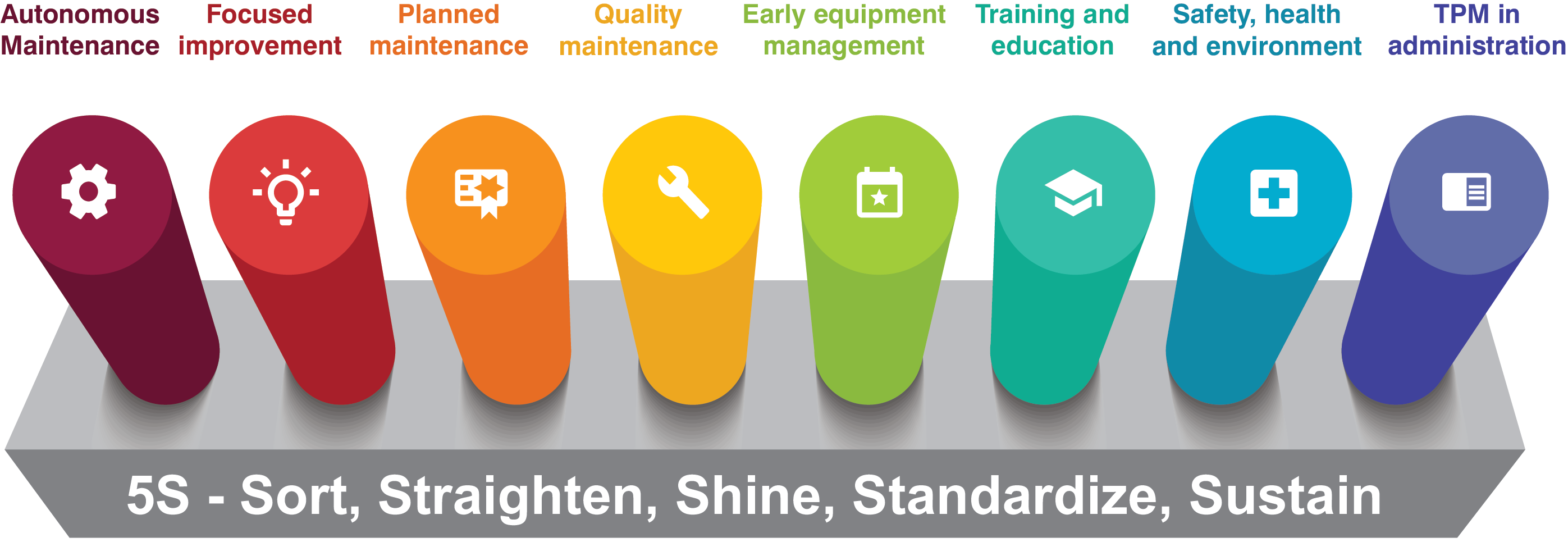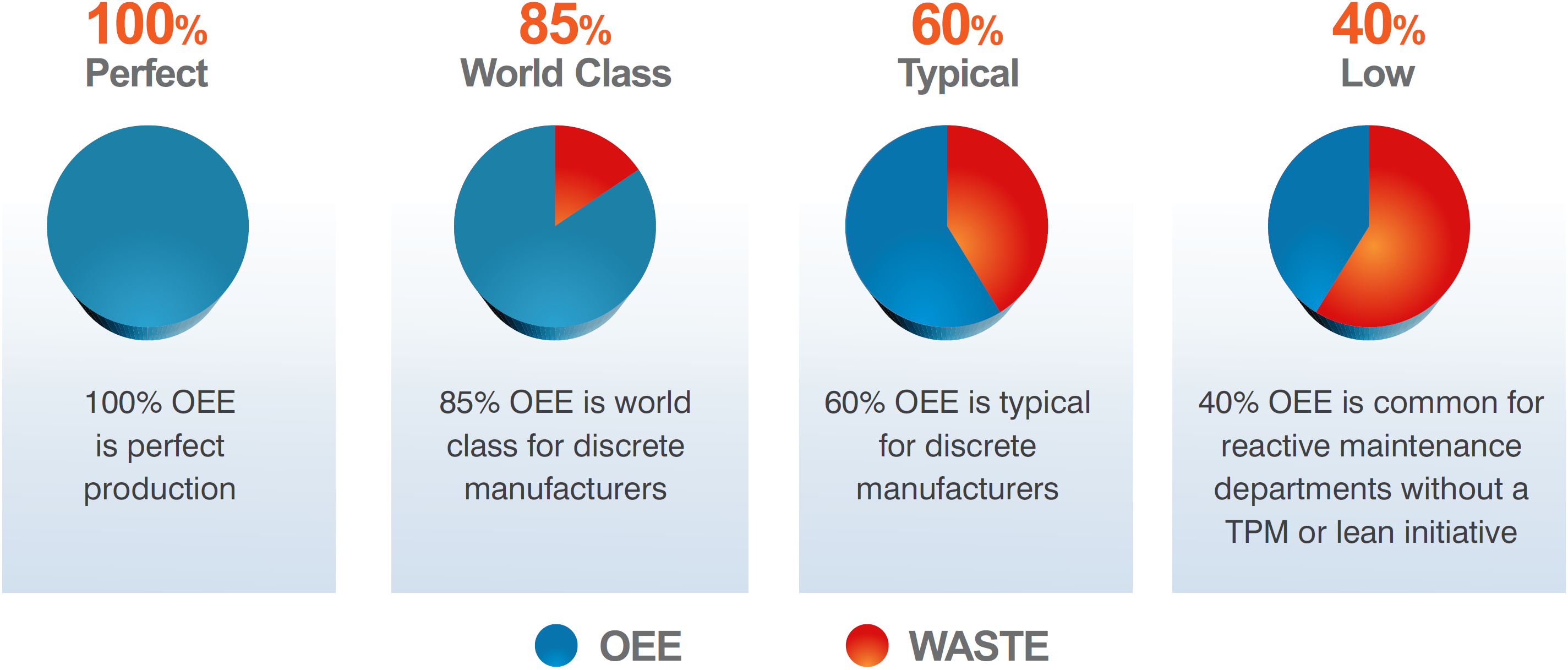5 Ways to Get Started with Total Productive Maintenance
October 20, 2022Total Productive Maintenance (TPM) was developed in Japan more than 50 years ago as a method of physical asset management focused on maintaining and improving equipment used in manufacturing processes to reduce operating costs. TPM was subsequently expanded to incorporate lean manufacturing techniques.
Today, more and more plants are turning to TPM to complement innovative maintenance technologies and provide a means of structuring and improving proactive maintenance strategies. In this article, we will consider some of the benefits of TPM and explore 5 ways that your plant can get started with Total Productive Maintenance.

Why Total Productive Maintenance?
Total Productive Maintenance emphasizes preventive and proactive maintenance strategies to optimize machine performance and help achieve “perfect production”. TPM differs from other maintenance strategies in that it extends maintenance responsibilities beyond technicians to include equipment operators. Operators perform routine maintenance tasks which allows technicians to focus on more complex tasks. This benefits organizations in many ways including:
- Less unplanned maintenance. Through carefully planned and scheduled maintenance, equipment is more reliable, and plants experience less unplanned downtime.
- Lower costs. TPM boosts Overall Equipment Efficiency (OEE) which helps to increase production capacity and reduce production costs.
- Safer workplaces. Total Productive Maintenance incorporates lean manufacturing principles, helping to identify underlying problems and systematically organize and maintain a safe working environment.
- Improved job satisfaction. TPM gives operators ownership and confidence in managing their equipment while reducing the burdens placed on maintenance teams.
- Higher quality. TPM Total Productive Maintenance helps improve the quality and consistency of production while reducing scrap. Fewer mistakes save time and money.
The results? As measured by Overall Equipment Effectiveness (OEE), a score of 40% is not uncommon for companies WITHOUT a TPM (or lean) program. And 100% or Perfect Production is a possibility.

Steps to Initiate a TPM Maintenance Program
Whether you are just staring or advancing your efforts – make sure you are considering these 5 proven ways to make progress.
1) Create an Organizational Support Structure
The success of a Total Productive Maintenance program is highly dependent on building a solid organizational support structure. The impact that organizational culture has on TPM performance has been the subject of many studies. According to a research paper in the International Journal of Innovative Science and Research Technology, authors found that “employees’ awareness to always provide optimal performance is shaped by organizational culture.” And, that an organizational culture focused on risk mitigation and reliability was critical to TPM success.
Education and training are key components of a strong organizational support structure. It takes time to learn TPM principles and how to perform autonomous maintenance tasks. If workers do not receive adequate education and training, it can result in maintenance tasks not being performed correctly or safely.
Establishing cross-functional teams is another important aspect of a successful TPM program. Members of cross-functional teams include workers from different departments as well as management. Operators, technicians, and engineers all play critical roles to identify problems, brainstorm potential remedies, select the best options, implement, and evaluate the impact of the solutions. All team members play a role in continuous process improvements as the organization strives for perfect production.
2) Develop an Autonomous Maintenance Program
Autonomous maintenance (AM) is one of the 8 Pillars of Total Productive Maintenance. AM is a preventive and proactive approach in which production operators perform routine maintenance tasks, such as cleaning equipment and diagnosing potential issues. This frees up maintenance staff to focus on more complex maintenance tasks, providing greater value to the organization. But more than that, AM helps to eliminate costly breakdowns, reduce unexpected downtime, maximize equipment performance and service life, and helps to promote a culture of safety and quality.
While every organization faces unique maintenance challenges, every autonomous maintenance program consists of several core steps. These include:
- Increasing operator knowledge. Operators are educated on how to operate and maintain the equipment that they use.
- Initial cleaning and inspection. Once they know the ins and outs of the machine that they are using, operators can identify components that require cleaning.
- Eliminating causes of contamination. Once the equipment is cleaned, operators maintain cleanliness to prevent contamination and keep their workspace safe.
- Establishing standards for lubrication and inspection. Equipment is lubricated and maintained according to the manufacturer’s specifications to maintain optimal performance and longevity.
- Conducting inspections and monitoring. This process reinforces good practices and helps collect valuable data to monitor performance.
- Standardizing maintenance processes. Adopting standardized visual cues like signs and color-coded tags throughout the plant makes it easier for operators to complete maintenance tasks.
- Establishing continuous improvement. Cross-functional teams should use the data collected to continuously improve equipment maintenance procedures.
3) Measure Overall Equipment Effectiveness (OEE) Data
Overall Equipment Effectiveness (OEE) is a measurement that helps organizations identify the percentage of manufacturing time that is actually productive. OEE accounts for three sources of loss:
- Availability. Any event that causes production to stop for a significant amount of time.
- Performance. Factors that cause a process to operate below maximum speed.
- Quality. Products that require rework due to quality issues.
Measuring OEE is a manufacturing best practice and provides management with actionable insights to improve the manufacturing and maintenance processes. TPM maintenance utilizes OEE data to prioritize and resolve issues that are causing availability, performance, or quality loss.
Many plants simply do not have processes in place to capture this data while others that do often have data gaps and data quality issues which stem from a lack of standardization. For instance, operators may note a broad range of reasons to describe the cause of a slow-down or stoppage event making the data difficult to analyze.
To overcome these challenges to accurately and reliably measure OEE data, organizations must implement new data collection processes. This includes consistently capturing relevant data and structuring it in a manner that facilitates analysis. For most plants, this means equipping technicians and operators with a mobile solution that allows them to immediately record data using a set of standardized responses. The data is automatically imported into the plant’s EAM database giving teams the information needed to identify where to focus their TPM efforts and plan continuous improvement activities.
4) Track Reliability Data in SAP
In addition to tracking OEE, tracking asset breakdown and failure data enables proactive maintenance approaches. Many plants operate on a reactive maintenance model. This “run-to-failure” method involves performing maintenance tasks as the need arises. A reactive maintenance strategy is not consistent with TPM goals since machines will not operate at peak efficiency and periodic breakdowns inhibit productivity.
Proactive maintenance strategies such as preventive, predictive, and reliability-centered maintenance all involve the analysis of reliability data. As we discussed above, implementing efficient data collection processes is a critical component of a successful TPM program. Reliability data enables the planning of proactive maintenance activities as well as identifies the “bad actors” or equipment that should be prioritized to reduce overall unplanned downtime.
5) Make a Commitment to Continuously Improve
If your TPM initiatives are well underway, you have been able to identify processes and equipment that are operating below par and preventing your organization from maximizing productivity. Your teams use what they learn to develop and implement proactive maintenance strategies. But you are not done. TPM maintenance is a long-term effort that requires a commitment from everyone within your organization to continuously improve.
Incentivize the process to recognize and reward employee achievements to increase buy-in. Offer ongoing training and education to increase operational and safety knowledge. Consistently re-evaluate processes and procedures to improve data collection, maintenance efficiency, and productivity. In addition, consider adopting other strategies that can help boost maintenance efficiency. For instance, early equipment management is a method that focuses on the design of equipment to make maintenance easier and more cost-effective.
Conclusion
Total Productive Maintenance is a proactive maintenance approach that seeks to maximize productivity by increasing equipment performance and reliability. TPM leverages operators to perform autonomous maintenance tasks while maintenance professionals can focus on more complex tasks. As such, for TPM to be successful, everyone within an organization must be involved, trained, and incented to achieve the program’s OEE goals.
Establishing efficient processes to collect and analyze quality data is a key component of TPM’s success. This involves consistently capturing data and structuring it in a way that facilitates analysis. Equipping technicians and operators with a mobile solution that standardizes responses and automatically imports it into the plant’s database systems gives cross-organizational teams the information they need to plan continuous improvements.
Download your free copy of The Total Productive Maintenance Guide for SAP Plant Maintenance e-book to learn more about the ins and outs of TPM and how it can help to transform your manufacturing processes.
Your Partner in TPM Success
Sigga has over two decades of experience in optimizing plant maintenance processes within asset-intensive industries. We are an SAP Certified Partner that offers industry-leading mobile EAM maintenance solutions. Sigga EAM Empower is a ready-to-deploy mobile maintenance app that comes with a built-in no-code app editor. The solution integrates seamlessly with SAP Plant Maintenance, streamlining the collection of data and giving management teams access to real-time data and actionable insights. Moreover, the app allows those with no coding knowledge to effortlessly create custom workflows and structure data capture.
Sigga’s Planning and Scheduling solution makes it easy to automate scheduling tasks with SAP Plant Maintenance. Maintenance planners can develop and implement proactive maintenance strategies to ensure the long-term success of your Total Productive Maintenance initiative.
Learn More About Sigga’s Solutions

